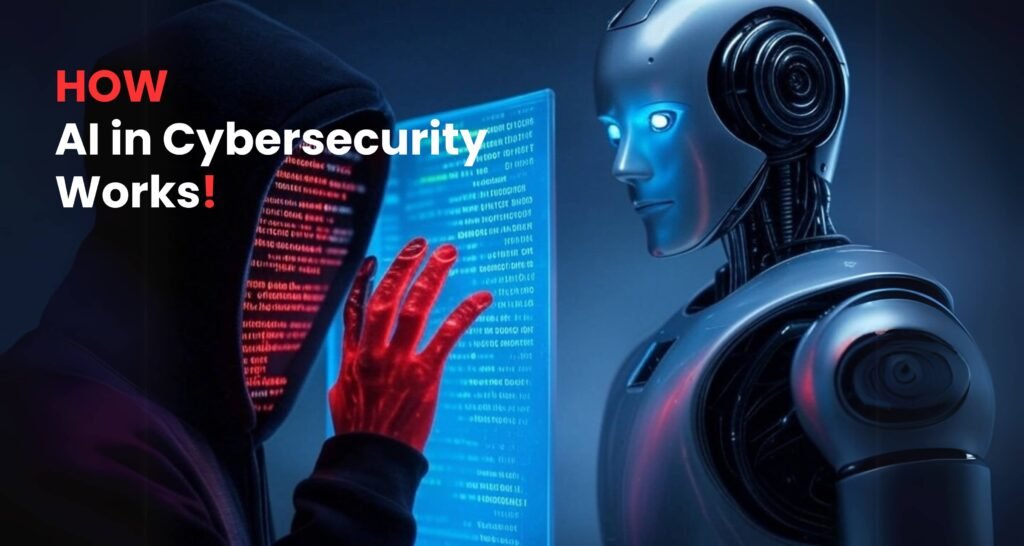Introduction: AI – The New Frontline Defender Against Cybercrime
Modern AI in cybersecurity systems don’t just react—they learn and adapt in real-time. Using machine learning, these platforms analyze billions of data points to spot anomalies, predict attack patterns, and automatically neutralize threats before damage occurs. For example, AI can detect a phishing email’s subtle linguistic cues or recognize never-before-seen malware by its behavior. Some advanced systems even deploy countermeasures like isolating infected devices or patching vulnerabilities—all without human intervention. This proactive, intelligent defense is revolutionizing how businesses stay protected in our era of AI-powered cyber threats.
Cybercriminals weaponize AI for advanced threats like self-learning malware, voice-cloned phishing, and bot-driven attacks. Defenders counter with AI-powered anomaly detection, predictive threat hunting, and automated patching systems that neutralize risks in milliseconds. This arms race demands smarter tools—here’s how AI is reshaping cyber defense.
- How AI detects threats 100x faster than humans
- Real-world cases where AI stopped major breaches
- The future of AI-powered cyber defense
How AI in Cybersecurity is Revolutionizing Threat Detection
1. Real-Time Anomaly Detection
Traditional security tools rely on known threat signatures. AI-powered systems (like Darktrace) use unsupervised learning to:
- Detect unusual behavior (e.g., abnormal login times)
- Flag zero-day exploits missed by rule-based tools
- Reduce false positives by 93% compared to legacy systems
Case Study: In 2023, an AI in cybersecurity system at a Fortune 500 company stopped a supply chain attack by spotting a 1-second deviation in data transfer patterns.
2. AI vs. Phishing & Social Engineering
- Natural Language Processing (NLP) scans emails for malicious intent (e.g., urgency, fake links).
- Computer Vision detects deepfake videos used in CEO fraud.
Example: Google’s Gmail AI blocks 99.9% of phishing attempts before they reach inboxes.
AI in Cyber Attack Prevention
1. Predictive Threat Hunting
AI analyzes global attack patterns to predict where hackers will strike next. Tools like CrowdStrike Falcon use:
🔹 Behavioral biometrics (typing speed, mouse movements)
🔹 Threat intelligence feeds (cross-referencing dark web data)
Result: Companies using AI-driven prevention see 60% fewer breaches (Accenture 2024).
2. Autonomous Response Systems
Some AI tools now automatically neutralize threats:
- Isolate infected devices
- Patch vulnerabilities in real-time
- Deploy decoy networks to mislead hackers
Example: Microsoft’s Azure Sentinel autonomously blocked a ransomware attack mid-execution by recognizing file encryption patterns.
AI vs. Traditional Cybersecurity: A Comparison
| Feature | Traditional Tools | AI-Powered Systems |
|---|---|---|
| Threat Detection | Signature-based (known threats) | Behavioral analysis (unknown threats) |
| Response Time | Minutes-hours | Milliseconds |
| False Positives | High (30-40%) | Low (<5%) |
| Adaptability | Manual updates needed | Self-learning models |
The Risks & Limitations of AI in Cybersecurity
1. Adversarial AI Attacks
Hackers now trick AI models by:
- Poisoning training data (feeding false info)
- Evasion attacks (modifying malware to appear benign)
Defense: AI systems must use adversarial training (like IBM’s Watson for Cybersecurity).
2. Over-Reliance on Automation
AI can’t replace human judgment for:
- Legal/ethical decisions (e.g., data privacy)
- Complex social engineering investigations
The Future: Where AI in Cybersecurity is Headed
1. AI-Powered Cyber Ranges
Companies like Palo Alto Networks are building AI battle simulators where systems train against hyper-realistic attacks.
These AI in cybersecurity ranges simulate advanced persistent threats, letting security teams test defenses against ransomware, supply chain attacks, and zero-day exploits before they strike in real-world scenarios – turning reactive security into proactive prevention
2. Quantum AI Security
Future AI models will use quantum-resistant encryption to protect against next-gen hacking and simulate attacks to strengthen defenses proactively
3. AI as a Service (AIaaS)
Small businesses will access enterprise-grade AI in cybersecurity via cloud platforms like AWS AI Shield; while AI-powered threat alerts slash response times by 80%. And AI blocks 90% of zero-day attacks
“AI vs AI: The silent war where algorithms attack and defend in milliseconds“
